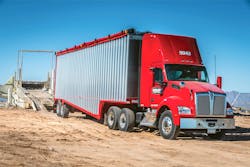Green Fleet of the Month: Lighter pays
Fleets look for every fuel-economy advantage they can get, but for those operations that gross out in weight on nearly every trip, it’s not only the fuel economy that matters. It’s the overall vehicle weight.
Ecology Recycling and Transportation Services is one of those fleets. With locations in California and Arizona, the fleet is the largest bulk waste and recyclables company west of the Mississippi with over 600 trucks. And every pound counts.
“Contract waste hauling is a very competitive business, which requires very accurate cost accounting and revenue projections,” Greg Evans, equipment maintenance manager for Ecology, says. “It comes down to who can haul the most trash at the lowest cost.”
A recent contract in the Phoenix area is an example of the fleet’s attention to weight reduction. Lightweight specs on a fleet of new Kenworth T880s and trailers have helped Ecology maximize loads and improve fuel mileage.
“All told, we decreased weight by about 2,000 lbs. compared to other combinations we’ve run in the past,” Evans notes. “The biggest contributor was going with the Paccar MX-11 engine, which is 400 lbs. lighter than a 13L engine. We have always been believers in the Paccar MX-13 engine and run those with great success in California with our Kenworths. But we can save weight and have comparable performance with the MX-11 engine.”
Ecology has purchased 450 Kenworth trucks since 2010 through Inland Kenworth in Montebello, CA. Spec’d with ratings of 430 hp. and 1,550 lbs.-ft. of torque, those Phoenix vehicles—61 T880s with 116.5-in. BBC short hoods—are hauling waste from transfer stations to landfills between 80 and 120 mi. away with no slip in performance with the 11L engine compared to the 13L.
“The Paccar MX-11 has the same horsepower rating as we’re running with the MX-13 engine, but with a different torque rating,” Evans says. “We’re not seeing any difference in top-end performance, and in Arizona, we’re able to run up to 75 mph. [Even though] we gross out on nearly every load at 80,000 lbs., we’re finding the pulling power to be excellent. The smaller engine is working well, and we expect it to have the same life as our bigger Paccar engines.”
The lighter engine is not the only weight-saving initiative that has led to improved fuel economy.
Notably, super single tires are not spec’d on the tractors and 48-ft. trailers.
“We really looked at all areas to cut weight,” Evans says. “We even took out the passenger seats on the trucks since they’re not needed and went with two batteries instead of three.
“We’ve seen a marked improvement in fuel economy with the Paccar MX-13 in our California operation, and we expect similar performance if not better with the MX-11 once the trucks are broken in,” he adds. “The combination of a lightweight vehicle, low maintenance costs—quite a bit lower than other brands of trucks we’ve run—and top fuel economy are helping to drive new business for our company. What’s more, our drivers really love being behind the wheel of the T880.”
